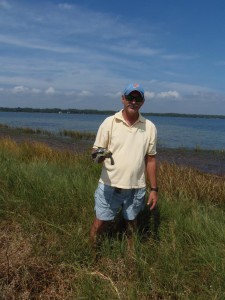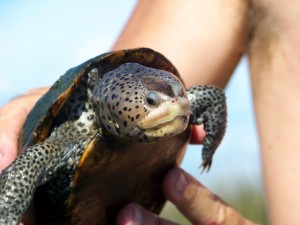Recently I watched a documentary on TV entitled The Loneliest Whale; the search for 52. The title grabbed my attention and so, I checked it out.

There are many forms of wildlife that are very hard to find in our area. But we continue to look.
Photo: Rick O’Connor
Seems a decade or so ago the U.S. Navy was doing SONAR work in the Pacific between Washington and Alaska and detected a strange sound coming in at 52 hertz. They had not herd this before and would continue to hear it in different locations around the northern Pacific. Their first concern was it was something new from the Russians, but when they showed the graphs and played the recording to a marine mammologist named Dr. Watkins, they found that it was most likely a “biological” – mostly likely a whale.
The problem was that Dr. Watkins had never heard whales calling at 52 hertz. If it was a whale, it was calling a lot – but no other whales were answering. Hence the name “the loneliest whale”. If it was a whale, and no others would talk to it, it was kind of sad. But who was this whale? What kind was it?
Word of the loneliest whale spread around the world and many humans made a connection to this animal, possibly because of their own disconnect with their own species. Stories and ballads were written, and people began to feel for the poor animal that apparently had no friends.
This story caught the attention of a documentary film maker who was interested in finding “52”, as the whale became known. He solicited the help of other marine mammologists; Dr. Watkins had died. According to those marine mammologists, this was going to be VERY difficult. It is hard enough to find just a pod of whales in the open Pacific, much less a specific pod with a specific individual. But they were excited about the challenge of finding this one animal, “52”, and off they went.
As I was watching this documentary it reminded me of my own search here near Pensacola. In 2005, I was asked by members of state turtle groups if I could search to see if diamondback terrapins lived in the western panhandle. This turtle’s range is from Cape Cod Massachusetts to Brownsville Texas, but there were no records from the Florida panhandle. Did the animal exist there? I was running the marine science program at Washington High School at the time and thought this would be a good project for us. So, we began.

This small turtle can be held safely by grabbing it near the bridge area on each side.
Photo: Molly O’Connor
The students researched terrapin biology and ecology to determine the locations with the highest probability of finding, and we searched. I quickly found that the best time to search for terrapins was during nesting in May and June, and that the worst time to do a project with high school seniors was May and June. So, the project fell on my wife and me. For two years we searched all the “good spots” and found nothing. We placed “Wanted Poster’s” at boat ramps near the good spots with only calls about other species of turtles, not the terrapin.
Then one day in a call came in from a construction worker. Said he had seen the turtle we were looking for. For over a year we had been chasing “false calls” of terrapins. So, I was not overly excited thinking this would be another box turtle or slider. I asked a few questions about what he was looking at and he responded with “you’re the guy who put the wanted poster up correct? – well your turtle is standing next to the poster… it’s the same turtle”. Now I was excited. We did some surveys in that area and in 2007 saw our first terrapin! I can’t tell you how exciting it was. Two years of searching… at times thinking we might work on another project with a different species that actually exists… reading that the diamondback terrapin is like the Loch Ness monster – everyone talks about them, but no one has ever seen one. And there it was, a track in the sand and a head in the water. Yes Virginia… terrapins do exist in the Florida panhandle. The excitement of finding one was indescribable.
We were hooked. We now had to look in other counties in the panhandle, and yes, we found them. As I watched the program of the marine mammologists searching for “52” I could completely relate.
Today, as a marine educator with Florida Sea Grant, I train others how to do terrapin surveys and searches. I let them know how hard it is to find them and to not get disappointed. When they do see one, it will be a very exciting and fulfilling day. Our citizen science program has expanded to searching for other elusive creatures in our bay area. Bay scallops, which are all but gone however we do find evidence of their existence and spend time each year searching for them. In the five years we have been searching we have found only one live scallop, but we are sure they are there. We find their cleaned shells on public boat ramps – by the way, it is illegal to harvest bay scallops in the Pensacola Bay area. Another we are searching for is the nesting beaches of the horseshoe crabs. This is another animal that basically disappeared from our waters but are occasionally seen now. It is exciting to find one, but we are still after their nesting beaches and the chase is on.
I love the challenge of searching for such creatures. If you do as well, we have a citizen science program that does so. You can just contact me at the Escambia County Extension Office to get on the training list, trainings occur in March, and we will get you out there searching. As for whether they found “52”, you will have to watch the program 😊
- Rattlesnakes on Our Barrier Islands; Part 4 – Thermoregulation - December 29, 2025
- Rattlesnakes on Our Barrier Islands; Part 3 – Envenomation - December 22, 2025
- St. Joe Red Tide Claiming Terrapins - December 15, 2025



